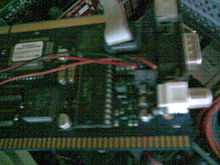Individual Computers Catweasel

The Catweasel is a family of enhanced floppy disk controllers from German company Individual Computers. These controllers are designed to allow more recent computers, such as PCs, to access a wide variety of older disk formats using standard floppy drives.
Principle
The floppy controller chip used in IBM PCs and compatibles was the NEC 765A. As technology progressed, descendents of these machines used what were essentially extensions to this chip. Many other computers, particularly ones from Commodore and early ones from Apple write disks in formats which cannot be encoded or decoded by the 765A, even though the drive mechanisms are more or less identical to ones used on PCs. The Catweasel was therefore created to emulate the hardware necessary to produce these other low-level formats.
The Catweasel normally sits between the computer's floppy interface and the floppy drives, modifying the signals as they pass. This allows one to mount PC floppies and then read or write, say, Amiga floppies without needing separate drives. The card may also be operated alone. Foreign formats may be read and written in a setup like this, but regular PC floppies cannot be mounted. In any case, a Catweasel cannot be used to boot a computer unless it is assisted by a regular PC floppy interface.
Supported formats:
| System | Floppy | Size |
|---|---|---|
| Amiga | 3.5" | 880, 1760 KB [1] |
| Apple Macintosh | 3.5" | 400, 800, 720, 1440 KB [1] |
| MS-DOS | 3.5" | 720, 1440 KB [1] |
| MS-DOS | 5.25" | 360, 720, 800, 1200 KB [1] |
| Atari ST | 3.5" | 360, 720, 800, 1440 KB [1] |
| Atari 800 XL | 5.25" | 130, 180 KB [2] |
| Apple II | 5.25" | 140 KB [1] |
| Commodore 1541 | 5.25" | 170 KB [1] |
| Commodore 1571 | 5.25" | 170, 341 KB [1] |
| Commodore 1581 | 3.5" | 800 KB [1] |
| Catweasel Extra | 3.5" | 1160, 2380 kB [1] |
| Nintendo backup station | 3.5" | 1600 KB |
Versions
Mk1 and Mk2
The initial version of the Catweasel was introduced c. 1996 and has since undergone several revisions. The Catweasel Mk1 for the PC ISA bus and Catweasel Mk2, for the Commodore Amiga 1200 and Amiga 4000, sold out in October 2001. The Mk3 added PCI compatibility and sold out in mid-2004. It was succeeded by the Mk4.
Official software and drivers are available for Windows,[3][4] and unofficial drivers and utilities are available for Linux.[5]
Mk3
The Catweasel Mk3 was designed to interface with either a PCI slot, an Amiga Zorro II slot or the clock port of an Amiga 1200. In addition to the low-level access granted to floppy drives, it has a socket for a Commodore 64 SID sound chip, a port for an Amiga 2000 keyboard, and two 9-pin digital joysticks (Atari 2600 de facto standard).[6]
Mk4 and Mk4plus
The Catweasel Mk4 was officially announced on 18 July 2004, with a wide array of new features planned. However, due to manufacturing delays and production backlogs, the Mk4 was not released until early February 2005.
This version of the Catweasel makes heavy use of reconfigurable logic in the form of an Altera ACEX EP1K30TC144-3N[7] FPGA chip, as well as an AMD MACH110 PLD and a PCI interface IC. The Mk4/Mk4+ driver uploads the FPGA microcode on start, which makes easy updates possible without having to replace hardware.
The Catweasel Mk4Plus appears to be no longer available.[8]
References
- ↑ 1.0 1.1 1.2 1.3 1.4 1.5 1.6 1.7 1.8 1.9 "Amiga Hardware Database - Expansion cards". 100702 amiga.resource.cx
- ↑ "Individual Computers: Catweasel". 100702 beta.icomp.de
- ↑ "Catweasel Mk4plus Product Page". Retrieved 15 January 2012.
- ↑ "Individual Computers Beta Software and Drivers". Retrieved 15 January 2012.
- ↑ "Catweasel Linux driver list". Retrieved 15 January 2012.
- ↑ "Hires pictures".
- ↑ "Catweasel User Manual" (PDF). p. 4. Retrieved 15 January 2012.
- ↑ "Individual Computers Price List". Retrieved 15 January 2012.
External links
- Official wiki
- Catweasel product webpage, Catweasel MK4 announcement
- Catweasel Floppy Read/Write Tools for TRS-80 & DEC RX02 diskettes
- ACID 64 Player - C64 Music Player for all HardSID cards and the Catweasel MK series
- Karsten Scheibler's Linux kernel driver and command-line utility
- Michael Krause's Linux block-device kernel driver
- Arjuna floppy controller software homepage
- AmigaOS & MorphOS driver development page
- Reading 1541 reverse sides
| ||||||||||||||||||||||||||||